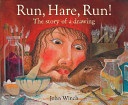John Winch is inspired by the drawing of a hare by Albrecht Dürer, a famous German artist who lived between 1471 and 1528. He wondered, was the hare drawn from life or a museum specimen? The story begins with endpapers featuring a countryside with castle turrets and medieval buildings, a distant village, and a cultivated countryside. Atop the hill is a wild brown hare.
‘Run, Hare, Run!’ is the repeated refrain showing the hare chased initially by a curious man (an artist) then cow, wolf and ducks. What will become of the hare? Deep, rich colours capture the lush countryside, life within a medieval town and the painter’s home.
The hare is hunted by a curious man (an artist) then chased by farmyard animals. Each subsequent double page spread offers lush, painterly landscapes with animals invariably in pursuit or betraying the hare’s presence. Exhausted, the hare runs into the cobbled street and lane, cathedral, busy market square and into to a barn, where exhausted, he is caught. What will become of the hare?
Close scrutiny of the hare’s captor reveals the same person from the woods. The ‘hare trembled with fear and shivered with cold as the hunter prepared his tools.’ A glance around the room reveals only a painter’s tools. The hare waits, the painter paints. The final double page spread features a red background and Albrecht Dürer’s famous painting of the hare.
John Winch (1944-2007) was a multi-award-winning painter, printmaker, sculptor and illustrator whose works have been exhibited around the world. About this book Wince says, ‘Since I first set eyes on a reproduction of The Hare by Albrecht Durer, I have been attracted by its simplicity and grace, and wondered about the story behind the drawing… Little is known about the picture – was it drawn from life, or from a museum specimen? – but the artist’s love of nature is evident in his simple and economical rendering of the hare. Personally, I am sure it was drawn from life!’

